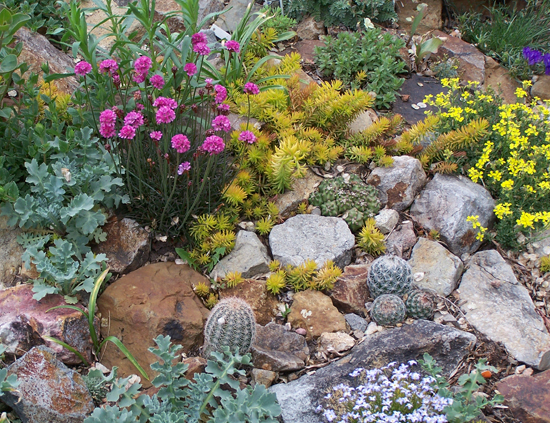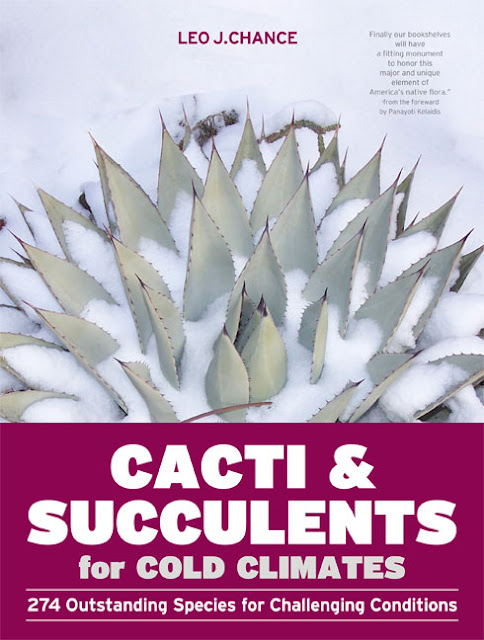Thinking about making an arid or xerophytic bed? Getting more into cacti and succulents and wanting to know more about growing this fabulous group of architectural plants in a colder region? Do you want to grow some of these plants outside but afraid that (British) winters may be too cold or wet for all of them? Then do get this most helpful and well written book, for your questions are more likely to be answered!
As I ponder myself on the idea of making a dedicated arid bed for the first time at the front of our house (the raised beds in our new area do not count) I am pleased to have got hold of this book which I have found most helpful in more ways than one. Not only does it list a selection of cacti and succulents, chosen for their suitability in being grown in colder regions, but it also gives cultivation hints on the best way to grow them. Extra information is also given on individual plants listed, on top of the general recommendations, to help them sail through cold (and wet) winters.
Most of the plants that are listed were chosen based on the author's own experience in growing them in his own garden for many years, in Denver, a zone 5 (winter minimums down to -20F/-28C) region. Several of the photographs featured were taken from his own garden, and from the gardens of other generous enthusiasts, all showing how well their plants are thriving in their gardens that are colder and outside the 'cactus country'.
 |
| Cacti and some companion plants in the author's garden (photo from Timber Press website) |
Although most of the cultivation notes were based on conditions found in colder regions of North America, there are also plenty of references of growing these succulents in areas that also experience wet winters. Conditions that are similar to most parts of the British Isles which makes some of the advice applicable to the UK, as well as some direct references to growing them here.
Without giving away too much, the book has sections on understanding hardiness, cultivation notes, propagation, watering and water requirements, lists of recommended cacti and other succulents, and even companion planting. The book is written in a way that it is easy to understand and practical, giving plenty of hints and tips to guide someone wanting to take on the challenge of growing cacti and succulents in colder regions.
On a personal note, it was great and definite plus points to read advice on making raised beds, the need for winter sun, planting mix, and if needed the use of frost fleece and rain shelters. Details like these tend to be omitted in other books but are actually very helpful on a practical level. A section on the importance of provenance towards influencing the potential for cold hardiness of plants is also there, a section that I was really pleased to see.
The only minor criticism I have for this book are the small photos on the individual plant section. I wish they were bigger to enhance appreciation of the plants mentioned. But apart from that this book is a very welcome addition to our library that no doubt we will refer to many times through the year. And if you're into cacti and succulents, or at least starting to venture into it, you'll find it as useful, informative, and entertaining to read as we did.
Read a fun interview of the author Leo J. Chance on the Timber Press Blog here.
Mark :-)


 This gardening blog follows our journey as we create our Tropical and Exotic themed garden. We hope you'll enjoy the journey as much as we do. We started our Exotic Garden in 2005 and this site will show its development, as well as our travels, both abroad and within the UK to gardens, nurseries and friends.
This gardening blog follows our journey as we create our Tropical and Exotic themed garden. We hope you'll enjoy the journey as much as we do. We started our Exotic Garden in 2005 and this site will show its development, as well as our travels, both abroad and within the UK to gardens, nurseries and friends.














Sounds like a good read ... my Aloe aristata survives with no problems in my potting shed over winter with no heat or protection, but I guess that's because it's so dry. I'd be nervous trying succulents outside, exposed to the wet, but I guess it's just a case of the right setting, soil conditions and choice of plants...
ReplyDeleteHi Jane, thats the key, trail and error. Am i correct in thinking you are based in Bedfordshire too? The plants that do well for us should also be good for you too.
DeleteCacti are fascinating plants with such interesting architecture. I look forward to seeing your cactus garden!
ReplyDeleteHi Debs, early stages of planning at the moment, we havent 100% decided what we are going to do at the front. But im sure whatever we decide it will be shared on here.
DeleteThat is a wonderful cover photo, says it all really. Look forward to seeing your new bed take shape - you are obviously worried about getting bored once the Great Pond Project is finally completed ;-)
ReplyDeleteIm sure we will never get bored, plenty of ideas to do after the pond is finished. We just need the weather to warm up to fit the window and then fill it up!
DeleteWhat a fabulous new project! (I have to admit I thought the same thing as Janet...almost done with the pond, need a new project!). With all that reflected heat from the concrete/asphalt I bet cacti and succulents would be very happy at the front of your house. Plus you'd be the talk of the neighborhood too,I can't wait to see where this one takes you.
ReplyDeleteOh and I'm glad you enjoyed the book, it's a good one!
Ahh thanks for your input Loree, you're helping swing it towards having an arid bed at the front of the house :) We're still deciding whether to go traditional or do something different (and more us too) at the front, and an arid bed would be perfect for that. And yes, with it being south facing and surrounded by concrete, seems a perfect location for one. I just wish the area in front of our house was bigger!
DeleteI got that book for Christmas! A very useful resource, i'll be using Croston Cactus and Glenhirst Cactus Nursery to stock up once they are back up and trading again after Winter.
ReplyDeleteThanks for adding me to your blog roll, i'm flattered.
A pleasure! And I'll have to look up those two books you've mentioned too :)
DeleteWhat a useful book! I always think of succulents and cacti as being tropical, but of course, that is not the case. Good to know about this book - I think adding a few cacti here and there in my garden might make for some fun accents.
ReplyDeleteI like that idea Holley, adding a few cacti and succulents to be used as fun accents, as well as provide contrast :)
DeleteThat looks interesting as I have a growing thing for succulents and had an interesting conversation with a grower the other day who was trying to convince me my echivera would be OK outside. He failed
ReplyDeleteHi Helen, some echeverias are tougher than others but I don't think there is a truly hardy one. If not sure err on the side of caution and keep them under glass :)
DeleteI've been slowly adding succulents to my garden and appreciating them more all the time. I live in zone 9b with dry hot summers and cold winters. No snow but some nightime freezes. I move my succulents to protected areas for the winter. Thank you for the review of this interesting book. I will have to look for it!
ReplyDeleteHi Dorothy, your Zone 9b location opens you up to even more options with growing hardier succulent. Worth a try :)
DeleteThis sounds like an interesting book! I have been growing some cacti and succulents outside in pots...bringing them indoors for the Winter. I think they suit pots better in my landscape but they would look great in Santa Fe NM where my son lives!!!
ReplyDeleteHi Jayne, growing them in pots and shifted under cover in the winter is fine and perfectly suitable to most gardeners living in colder areas. I can imagine that they will look great in Santa Fe NM indeed :)
Delete